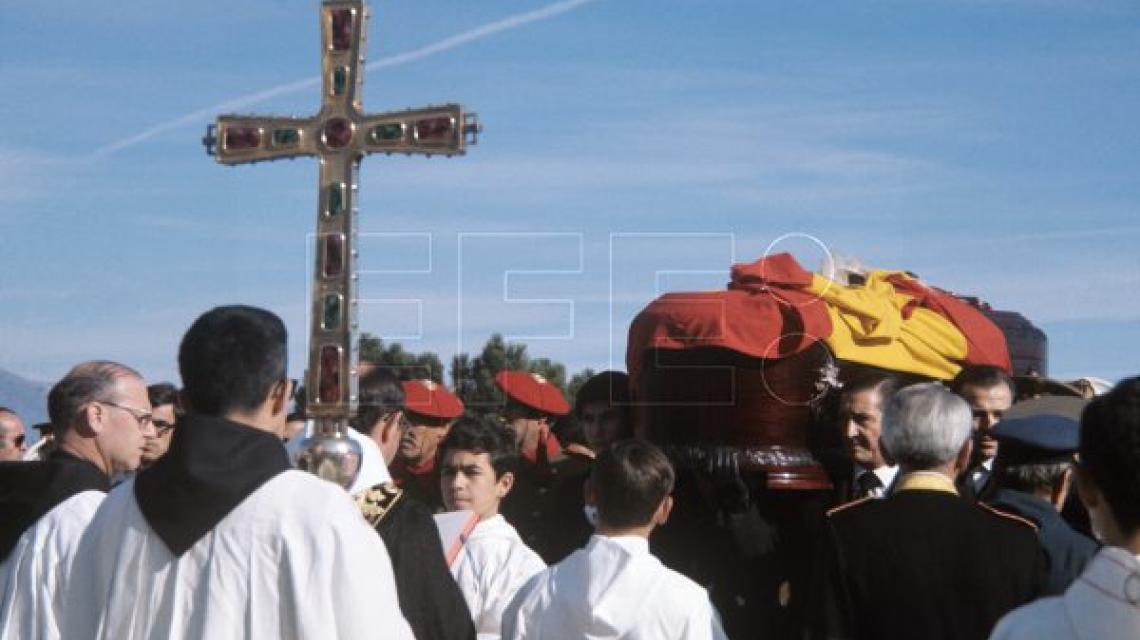
Francisco Franco died in La Paz Hospital in Madrid on 20 November 1975, and the long dictatorship finally came to an end. Although it is not clear how or at what point the decision was made, Franco was buried in the Valley of the Fallen on 23 November, after a carefully orchestrated and heavily militarized State funeral which was attended by political, religious and military authorities of the regime.
By contrast, diplomatic representation of senior foreign dignitaries was discreet, to which the international outrage sparked by the recent execution of three FRAP and two ETA members, barely three months earlier, undoubtedly contributed. The only foreign figures in a place of honour were Chilean dictator Augusto Pinochet, King Hussein of Jordan, Rainier of Monaco, the Philippine first lady Imelda Marcos and US Vice President, Nelson Rockefeller.
Franco’s body, dressed in his captain general uniform, first received a private wake in the funeral chapel in El Pardo and later in public in the Hall of Columns at the Royal Palace, where visitors numbered tens of thousands. The funeral ceremonies were shown live and in full by the official Spanish broadcaster. On 22 November, new King Juan Carlos I, who was crowned the same day, wrote to the abbot at the Valley asking him to receive Franco’s mortal remains and place them “in the tomb designed for that purpose, situated in the Chancel between the High Altar and the Choir of the Basilica”.
On the morning of the 23rd, once the funeral chapel had closed, the Bishop of Toledo and Cardinal Primate of Spain, Marcelo González, officiated the funeral and corpore insepulto mass in Madrid’s Plaza de Oriente, attended by the new monarchs. A funeral cortege subsequently took Franco to the Valley in a coffin placed on a military vehicle (Pegaso 3050) adapted for the occasion and escorted first by guard lancers, and later by a motorized squadron of the Civil Guard.
A huge crowd awaited on the concourse in the Valley, where an outdoor mass was held. The funeral procession was received by the Valley’s mitred Benedictine abbot holding the cross aloft. Franco’s body was borne across the concourse on the shoulders of his next of kin and handed over to the Benedictine monks at the door of the basilica, while the crowd outside chanted the Falange anthem Cara al sol, the March of Oriamendi, the anthem of the Spanish legion and other symbolic regime songs.
Once inside the basilica, the body was processed to the altar on the shoulders of members of the Regiment of the Guard of Honour, while the choir school and Benedictine choir intoned the antiphon In Paradisum. The organ then played the Spanish anthem. As the tomb was blessed, gun salutes were fired outside. The Spanish Television presenter providing the running commentary concluded: “History will record that, at 14.11 on Sunday 23 November 1975 in the Basilica of the Valley of the Fallen, Francisco Franco was interred (…) The stone slab, with its semi-circular trapezoid shape, made from granite and weighing 1,500kg, is placed on the grave”.
The coincidence of the shared date of death of José Antonio Primo de Rivera and Francisco Franco, 39 years apart, strengthened the memorial status of 20 November that had been established in the Valley with the transfer of Primo de Rivera shortly after its opening. For 44 years, Franco occupied a symmetrical position to that of Primo de Rivera, at the back of the altar behind the choir, until he was exhumed in 2019 to be moved to Mingorrubio Cemetery in El Pardo.